Achyranthes bidentata Polysaccharide Activates Nuclear Factor-Kappa B and Promotes Cytokine Production in J774A.1 Cells Through TLR4/MyD88 Signaling Pathway
- PMID: 34658894
- PMCID: PMC8517515
- DOI: 10.3389/fphar.2021.753599
Achyranthes bidentata Polysaccharide Activates Nuclear Factor-Kappa B and Promotes Cytokine Production in J774A.1 Cells Through TLR4/MyD88 Signaling Pathway
Abstract
Achyranthes bidentata Blume, a traditional Chinese medicine, is widely acknowledged for its function of invigorating the liver and kidneys and as a stranguria-relieving diuretic and used in the treatment of edema, gonorrhea, and other diseases. Polysaccharide (ABPS), isolated from Achyranthes bidentata Blume, has been demonstrated to have multiple biological activities including immunomodulatory effects. However, the mechanisms underlying the effects of ABPS have not been fully investigated. The present study is conducted to explore the underlying mechanism of immunomodulatory activities of ABPS. Results showed that ABPS significantly increased the secretion of IL-1β and TNF-α in J744 A.1 cells. Nitric oxide (NO) also significantly increased after ABPS treatment. The special antibodies (Toll-like receptor 4 (TLR4) antibody and CD14/TLR4 antibody) significantly decreased the activation, while the Toll-like receptor 2 (TLR2) antibody could not abolish this activation. Meanwhile, pyrrolidine dithiocarbamate (PDTC), a specific inhibitor of NF-κB, remarkably inhibited the secretion of IL-1β and TNF-α induced by ABPS in J744 A.1 cells. Western blotting (WB) and confocal laser scanning microscopy (CLSM) showed that ABPS promoted NF-κB translocation into the nucleus. Furthermore, the mRNA and protein expression of TLR4 and MyD88 were significantly increased after ABPS treatment. Taken together, these findings suggested that the immunomodulatory mechanism of ABPS was associated with the secretion of cytokines by stimulating the NF-κB pathway through TLR4/MyD88 signaling.
Keywords: Achyranthes bidentata; NF-kappa B; Toll-like receptors (TLRs); immunomodulatory; polysaccharides.
Copyright © 2021 Fan, Wang, Zhang, Wu and Chen.
Conflict of interest statement
The authors declare that the research was conducted in the absence of any commercial or financial relationships that could be construed as a potential conflict of interest.
Figures
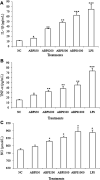
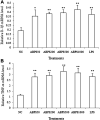

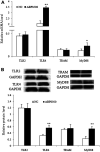
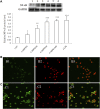
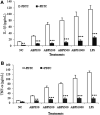
Similar articles
-
Sargassum fusiforme polysaccharide activates nuclear factor kappa-B (NF-κB) and induces cytokine production via Toll-like receptors.Carbohydr Polym. 2014 May 25;105:113-20. doi: 10.1016/j.carbpol.2014.01.056. Epub 2014 Jan 27. Carbohydr Polym. 2014. PMID: 24708959
-
Chlamydia abortus Pmp18.1 Induces IL-1β Secretion by TLR4 Activation through the MyD88, NF-κB, and Caspase-1 Signaling Pathways.Front Cell Infect Microbiol. 2017 Dec 18;7:514. doi: 10.3389/fcimb.2017.00514. eCollection 2017. Front Cell Infect Microbiol. 2017. PMID: 29326885 Free PMC article.
-
[The immunomodulatory effect of Achyranthes bidentata polysaccharides].Yao Xue Xue Bao. 1997 Dec;32(12):881-7. Yao Xue Xue Bao. 1997. PMID: 11596182 Chinese.
-
[Effect of Achyranthes bidentata polysaccharides stimulated dendritic cells co-cultured with cytokine induced killer cells against SW480 cells].Zhongguo Zhong Yao Za Zhi. 2013 Apr;38(7):1056-60. Zhongguo Zhong Yao Za Zhi. 2013. PMID: 23847957 Chinese.
-
Oligo/polysaccharides from Cyathula officinalis and Achyranthes bidentata: a review of structures and bioactivities.J Pharm Pharmacol. 2024 Apr 3;76(4):307-326. doi: 10.1093/jpp/rgae007. J Pharm Pharmacol. 2024. PMID: 38243389 Review.
Cited by
-
Immunomodulatory Effect of Phytoactive Compounds on Human Health: A Narrative Review Integrated with Bioinformatics Approach.Curr Top Med Chem. 2024;24(12):1075-1100. doi: 10.2174/0115680266274272240321065039. Curr Top Med Chem. 2024. PMID: 38551050 Review.
-
Gas chromatography (GC) fingerprinting and immunomodulatory activity of polysaccharide from the rhizome of Menispermum dauricum DC.PeerJ. 2022 Aug 22;10:e13946. doi: 10.7717/peerj.13946. eCollection 2022. PeerJ. 2022. PMID: 36032961 Free PMC article.
-
Protective role of Achyranthes bidentata polysaccharides against chondrocyte extracellular matrix degeneration through lncRNA GAS5 in osteoarthritis.Exp Ther Med. 2022 Jun 22;24(2):532. doi: 10.3892/etm.2022.11459. eCollection 2022 Aug. Exp Ther Med. 2022. PMID: 35837034 Free PMC article.
-
Natural plant-derived polysaccharides targeting macrophage polarization: a promising strategy for cancer immunotherapy.Front Immunol. 2024 Sep 16;15:1408377. doi: 10.3389/fimmu.2024.1408377. eCollection 2024. Front Immunol. 2024. PMID: 39351237 Free PMC article. Review.
References
-
- Allam H. A., Abd El-Salam M., Mohammad A., Aboulkhair A. G. (2015). Clinical Value of Toll like Receptor 4 and CD14 in Children with Acute Lower Respiratory Tract Infection. Int. Biol. Biomed. J. Summer. 1 (3), 90–97.
LinkOut - more resources
Full Text Sources
Research Materials

